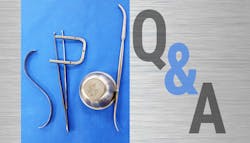Testing insulated electrosurgical devices for safety, monitoring washers, cleaning efficacy
Submit your questions: email: [email protected]
Q
Over the past few months, I have received several calls and notes with questions pertaining to insulated medical devices. Since this seemed to be somewhat of a hot topic, I decided to combine some of the concerns, precautions and questions into one response to share with all readers.
A
Minimally-invasive surgical (MIS) procedures provide many advantages for patient care, including smaller incisions, faster recovery times, reduced pain and scarring. MIS procedures frequently require the use of electrosurgical devices, helping to prevent blood loss. Electrosurgical devices utilize high-frequency electric currents to heat, cut and cauterize tissue with great precision (figure 1).
Electrosurgical instrumentation requires an insulation coating to contain the electrical currents, preventing them from burning the patient or staff. Stray currents can provide a source of ignition, causing a fire. The insulation of these instruments can be damaged or worn over time, resulting in breaks in the insulation and allowing the dangerous escape of electrical currents.
Annually, there are thousands of patient burn incidents documented in the US. One study showed that 25% of patients who are burned by stray currents will die. Findings have shown that one in five reusable laparoscopic instruments have an insulation failure. Approximately 67% of stray electrosurgical burns go unnoticed during surgery. Such events can result in severe patient care complications, infections, pain, extended hospitalization and prolonged recovery.
As evidenced by the vast number of patient burn incidents, visual inspection alone is not adequate to detect a leak or small hole in the instrument’s insulation. The only effective way to detect electrical current leakage and to ensure the safety of insulated electrosurgical instrumentation is to utilize an insulation testing device (figure 2).
Q
While completing my nursing degree, I worked in sterile processing as a shift supervisor for a few years; I enjoyed the position very much. After graduating, I have worked as an OR nurse for the past four years. Recently I accepted a position as the OR/sterile processing liaison; my number one charge is to get SPD ready for the Joint Commission inspection in a few months. I want to focus first on bringing our washers monitoring policy up to the current standards. Is once a week still acceptable? Does every washer need to be tested? Is it necessary to test every level of a washer or would a random shelf testing be acceptable? I want to have a good record of washer performance to prove that instruments processed through our washers are clean and safe for patient care.
A
Welcome back to Sterile Processing. Your previous experience combined with your nursing experience in the operating room will be of great value.
The current AAMI ST79 standards state:
Mechanical cleaning equipment performance should be tested each day the equipment is used. All test results should be recorded. It is important to note that these standards pertain to all mechanical cleaning equipment, such as washer disinfectors, ultrasonic washers, cart washers, automatic endoscope preprocessors (AERs) and their accessory components, e.g. washer racks, manifolds, adaptors and the like.
Whatever testing tools you utilize, they must be able to demonstrate the effective performance of the mechanical washer disinfector and its essential components. Testing an instrument disinfector would require testing each level of the washer. Each level of the washer rack contains spinner arms, which deliver the water, cleaning chemistry and necessary impingement to dislodge and remove soil. It is possible to have problems with a spinner, which would impede the effective functioning of the washer.
The testing of mechanical washers provides verification that the equipment is performing appropriately and can clean the contents of items placed in them. The tests do not prove that the instruments are clean.
Follow all IFUs for:
- reprocessing of each instrument, e.g. disassembly, precleaning, inspection
- processing equipment manufacturer, e.g. proper loading, positioning contents, appropriate cycle selection
- detergents, etc., e.g. appropriate chemicals and concentrations
- ensuring staff competency for all related tasks
- monitoring individual performance
Including all of the above with mechanical proficiency will provide a high confidence level for cleaning efficacy of items processed in the mechanical washer.
Post cleaning, individual instruments can be tested to verify there is no presence of residual soil on or within the device. Professional organizations, such as AAMI, SGNA and AORN, have recommendations for performing cleaning verification tests on certain complex instrumentation, such as those with channels, movable parts, crevices, angulations and difficult design features, which present a greater challenge to the cleaning process. There are various types of tests available for detecting residual soils, such as hemoglobin and carbohydrates.

Ray Taurasi
Ray Taurasi is Principal, Healthcare CS Solutions. His healthcare career spans over five decades as an Administrator, Educator, Technologist and Consultant. He is a member of AORN, SGNA, AAMI and a past president of IAHCSMM. Taurasi has been a faculty member of numerous colleges teaching in the divisions of business administration, nursing, and health sciences. He is the author of numerous articles and textbook chapters; he is a frequent speaker at national and international healthcare conferences.
Note to readers from Ray Taurasi - In 2021, my life’s career path will transition to one of new opportunities and adventures. As a result, after nearly 19 years and 225 CS Solution columns, this edition will be my last.
“All changes, even the most longed for, have their melancholy; for what we leave behind us is a part of ourselves; we must die to one life before we can enter another.”– Anatole France
I wish you and your loved ones a healthy and joyful holiday season and a beautiful New Year! God Speed, Ray
https://www.facebook.com/pages/category/ Local-Business/Healthcare-CS-Solutions-128857 3061153887/ • email: [email protected]







